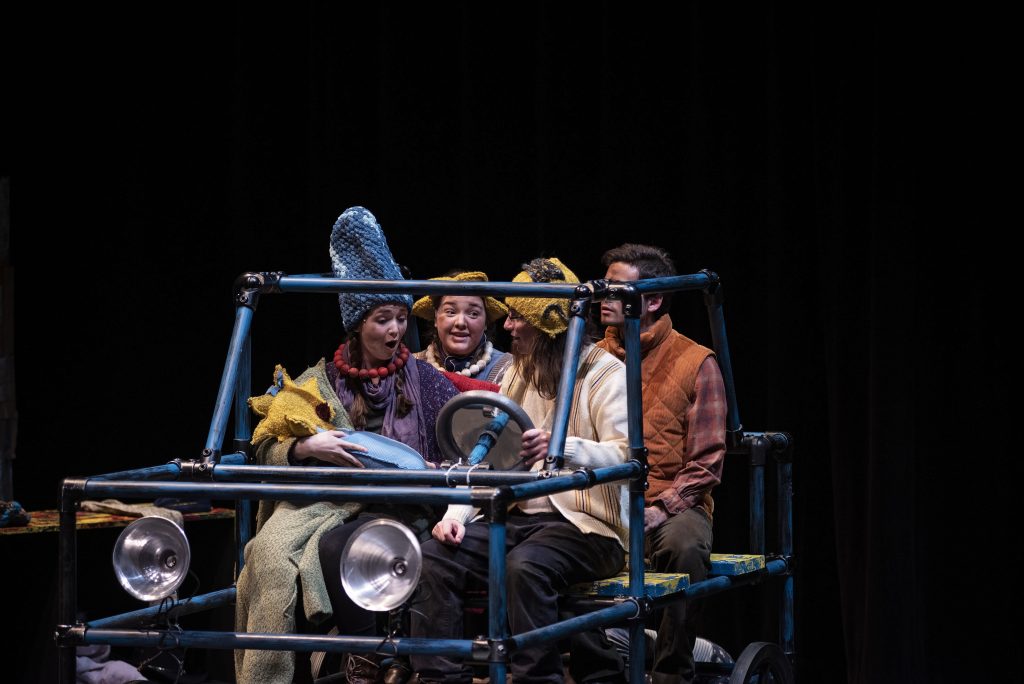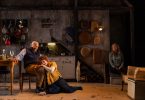By Siena Giljum
BU News Service
Apocalypse storylines are often left to the screen: “The Hunger Games,” “The Society,” “Mad Max.” Combining unsettling acappella music with 90s nostalgia, “Mr. Burns, a Post-Electric Play” is an anomaly to the stage in almost every way imaginable.
Suffolk Performing Arts brings together Suffolk University students on everything from theatre to real estate in this rendition of Anne Washburn’s work.
The company transforms into a weary group of survivors, fleeing from a mysterious, apocalyptic event that has brought the world to ruin. The audience is slowly clued in that a catastrophic plague has not only devastated their normal lives, but has also shut down the electricity grid.
With no end to this disaster in sight, the group begins their healing and coping the only way they know how: by retelling iconic episodes of “The Simpsons.” In the apocalypse, there are no reruns, no Wikipedia pages, not even a television. There is just the collective memory of the survivors.
Storytelling is commonly regarded as healing, whether cracking a joke to lighten the mood or remembering a loved one through anecdotes, but “Mr. Burns” takes this idea to new heights. It explores the human tendency to connect through popular culture, blowing it out of proportion over three distinct acts.
The group of survivors quietly and individually realizes that the only way to cope with the horrors of their post-apocalyptic landscape is to pour their energy into a huge passion project. They strive to recreate the world they once knew, all the while drawing more attention to their hunger for basics like water, electricity and the simple pleasure of Diet Coke.
Matt, the main storyteller from the get-go, was seemingly a “Simpsons” superfan in his pre-apocalypse life, while Gibson has never even seen an episode all the way through. But the whole company is able to find some sense of their bygone lives by telling what they remember from the most memorable episodes.

Act I is in the “very near future,” Act II is seven years later and Act III is 75 years after that. With the three parts of the story set so far apart, we see the characters pour themselves completely into becoming the most reputable local theatre troupe to produce staged renditions of beloved television shows. The product is complete with made-up commercials and gaudy headpieces to represent the “Simpsons” cartoon characters.
The iconic 1993 episode “Cape Feare,” in which the Simpson family enters the witness protection program after Bart receives death threats written in blood, serves as the guiding force throughout the three acts of “Mr. Burns.” The staging escalates from campfire storytelling to a high-stakes rehearsal, then to an eerie musical that hangs onto the original plot by a thread.
Survivor Colleen stays entirely silent through the first act, curled up in a ball, which is later explained by the fact that she lost her daughter in the chaos. But even she recognizes the value of moving forward in this new and warped reality by acting out a cartoon comedy for live audiences— so much so that by Act II she is the determined and fearless director of the troupe.
Suffolk plays to its local audience by adding quips about the area. “Boston’s a mess,” Gibson muses when probed by the group about his travels. It feels like a personal gesture meant to spark a few chuckles, but also sends shivers down the spine as we imagine the reality of the modern world being torn to shreds.
An open, versatile set allows for hefty pieces such as ragged couches, a giant car skeleton modeled from PVC pipes and a houseboat decorated with multi-colored Solo cups. Just like the dialogue and plot, the physical objects of “Mr. Burns” grow more surreal by the minute, as if they are blown-up echoes of the real world things they are supposed to represent.
It may seem like an outlandish version of reality, but when everything these characters know is gone – friends and family, work, school, proper cities or any sense of stability – they turn to one of the only things that connects them. In this case, “The Simpsons.”
“Mr. Burns, a Post-Electric Play,” by Suffolk University Performing Arts, ran from Feb. 20 to 22 at the University’s Modern Theatre as part of the program’s Pioneer Performance Series.





[…] Click here for the full story. #Boston#dystopia#News#Service#Simpsons#University […]